San Bernardino, California, Hgh State Clinic, Hgh Injections, Hrt Doctors
San Bernardino, California Blood Testing Facilities
 Represents a LabCorp blood testing facility
Represents a LabCorp blood testing facility Represents a Quest Diagnostics blood testing facility
Represents a Quest Diagnostics blood testing facility

Nearby Labcorp Blood Testing facilities:
- Labcorp Center Distance: 2 m, 399 E. Highland Ave. Ste 510, San Bernardino, San Bernardino County, CA, 92404
- Labcorp Center Distance: 6 m, 255 Terracina Blvd Ste 106, Redlands, San Bernardino County, CA, 92373
- Labcorp Center Distance: 12 m, 6927 Brockton Ave Ste 1B, Riverside, Riverside County, CA, 92506
- Labcorp Center Distance: 15 m, 34845 Yucaipa Bl. Ste B, Yucaipa, San Bernardino County, CA, 92399
- Labcorp Center Distance: 19 m, 1310 San Bernardino Rd Ste 107, Upland, San Bernardino County, CA, 91786
- Labcorp Center Distance: 20 m, 126 Avocado Ave. Ste 105, Perris, Riverside County, CA, 92571
- Labcorp Center Distance: 21 m, 17450 Main St. Suite C, Hesperia, San Bernardino County, CA, 92345
- Labcorp Center Distance: 22 m, 900 S. Main St. Suite 207, Corona, Riverside County, CA, 92882
- Labcorp Center Distance: 23 m, 12555 Central Ave. Ste Af, Chino, San Bernardino County, CA, 91710
- Labcorp Center Distance: 25 m, 12332 Hesperia Rd Suite B, Victorville, San Bernardino County, CA, 92395
- Labcorp Center Distance: 26 m, 1900 Royalty Drive Suite 230, Pomona, Los Angeles County, CA, 91767
- Labcorp Center Distance: 27 m, 3936 Phelan Rd. Suite F4, Phelan, San Bernardino County, CA, 92371
- Labcorp Center Distance: 29 m, 16008 Kamana Dr. Suite 201, Apple Valley, San Bernardino County, CA, 92307
- Labcorp Center Distance: 30 m, 31571 Canyon Estates Dr Ste101, Lake Elsinore, Riverside County, CA, 92532
- Labcorp Center Distance: 31 m, 850 E. Latham Ave. Ste Cd, Hemet, Riverside County, CA, 92544
- Labcorp Center Distance: 33 m, 500 S Anaheim Hills Rd Ste102, Anaheim, Orange County, CA, 92807
- Labcorp Center Distance: 34 m, 420 W. Rowland Street, Covina, Los Angeles County, CA, 91722
- Labcorp Center Distance: 35 m, 36320 Inland Valley Dr Ste 103, Wildomar, Riverside County, CA, 92595
- Labcorp Center Distance: 37 m, 29873 Santa Margarita Pkwy102, Rancho Santa Margarita, Orange County, CA, 92688
- Labcorp Center Distance: 38 m, 25405 Hancock Ave. Suite 107, Murrieta, Riverside County, CA, 92562
- Labcorp Center Distance: 39 m, 100 N. Tustin Avenue, Tustin, Orange County, CA, 92780
- Labcorp Center Distance: 40 m, 113 Waterworks Way Suite 160, Irvine, Orange County, CA, 92618
- Labcorp Center Distance: 41 m, 27699 Jefferson Ave Ste 209, Temecula, Riverside County, CA, 92590
- Labcorp Center Distance: 42 m, 7872 Walker St. Suite 109, La Palma, Orange County, CA, 92801
- Labcorp Center Distance: 43 m, 26691 Plaza Drive Suite 180, Mission Viejo, Orange County, CA, 92691
- Labcorp Center Distance: 44 m, 31150 Temecula Parkway Ste 201, Temecula, Riverside County, CA, 92592
- Labcorp Center Distance: 45 m, 11180 Warner Ave. Suite 155, Fountain Valley, Orange County, CA, 92708
- Labcorp Center Distance: 46 m, 555 E. Tachevah Dr. Suite 3E, Palm Springs, Riverside County, CA, 92262
- Labcorp Center Distance: 47 m, 1695 N Sunrise Way, Palm Springs, Riverside County, CA, 92262
- Labcorp Center Distance: 48 m, 17822 Beach Bl Suite 242, Huntington Beach, Orange County, CA, 92647
- Labcorp Center Distance: 49 m, 665 Camino De Los Mares 303A, San Clemente, Orange County, CA, 92673
- Labcorp Center Distance: 50 m, 587 E. Elder Street, Fallbrook, San Diego County, CA, 92028
- Labcorp Center Distance: 51 m, 1661 Golden Rain Rd, Seal Beach, Orange County, CA, 90740
- Labcorp Center Distance: 52 m, 1190 Pacific Coast Hwy Ste C, Seal Beach, Orange County, CA, 90740
- Labcorp Center Distance: 53 m, 38209 47Th St East Suite C, Palmdale, Los Angeles County, CA, 93552
- Labcorp Center Distance: 55 m, 35400 Bob Hope Dr. Ste 111, Rancho Mirage, Riverside County, CA, 92270
- Labcorp Center Distance: 56 m, 574 E. Virginia Way, Barstow, San Bernardino County, CA, 92311
- Labcorp Center Distance: 58 m, 73345 Highway 111 Suite 204B, Palm Desert, Riverside County, CA, 92260
- Labcorp Center Distance: 59 m, 2701 W Alameda Ave Ste 203, Burbank, Los Angeles County, CA, 91505
- Labcorp Center Distance: 61 m, 41120 Washington St Ste 105, Bermuda Dunes, Riverside County, CA, 92203
- Labcorp Center Distance: 62 m, 8737 Beverly Blvd Ste 401, Los Angeles, Los Angeles County, CA, 90048
- Labcorp Center Distance: 63 m, 2067 West Vista Way Suite 275, Vista, San Diego County, CA, 92083
- Labcorp Center Distance: 64 m, 79200 Corporate Ctr Dr.Ste 204, La Quinta, Riverside County, CA, 92253
- Labcorp Center Distance: 66 m, 1595 Grand Ave Ste 109, San Marcos, San Diego County, CA, 92078
- Labcorp Center Distance: 67 m, 15211 Vanowen St Ste 319, Van Nuys, Los Angeles County, CA, 91405
- Labcorp Center Distance: 68 m, 1821 Wilshire Blvd. Ste 210, Santa Monica, Los Angeles County, CA, 90403
- Labcorp Center Distance: 69 m, 1955 Citracado Pkwy Suite 103, Escondido, San Diego County, CA, 92029
- Labcorp Center Distance: 71 m, 18399 Ventura Blvd. Suite 17, Tarzana, Los Angeles County, CA, 91356
- Labcorp Center Distance: 72 m, 345 Saxony Rd Ste 201B, Encinitas, San Diego County, CA, 92024
- Labcorp Center Distance: 73 m, 23206 Lyons Ave Ste 109, Newhall, Los Angeles County, CA, 91321
- Labcorp Center Distance: 74 m, 351 Santa Fe Dr Ste 210, Encinitas, San Diego County, CA, 92024
Nearby Quest Blood Testing facilities:
- Quest Center Distance: 1 m, 2150 N Waterman Ave, San Bernardino, San Bernardino County, CA, 92404-4811
- Quest Center Distance: 10 m, 4646 Brockton Ave, Riverside, Riverside County, CA, 92506-0103
- Quest Center Distance: 12 m, 6485 Day St, Riverside, Riverside County, CA, 92507-0926
- Quest Center Distance: 15 m, 9041 Magnolia Ave, Riverside, Riverside County, CA, 92503-3956
- Quest Center Distance: 19 m, 1399 E Foothill Blvd, Upland, San Bernardino County, CA, 91786-4060
- Quest Center Distance: 22 m, 118 W 9Th St, Corona, Riverside County, CA, 92882-3320
- Quest Center Distance: 23 m, 2250 S. Main St, Corona, Riverside County, CA, 92882-2534
- Quest Center Distance: 25 m, 12370 Hesperia Rd, Victorville, San Bernardino County, CA, 92395-4787
- Quest Center Distance: 31 m, 32251 Mission Trl, Lake Elsinore, Riverside County, CA, 92530-4536
- Quest Center Distance: 33 m, 554 E San Bernardino Rd, Covina, Los Angeles County, CA, 91723-1748
- Quest Center Distance: 39 m, 801 N Tustin Ave, Santa Ana, Orange County, CA, 92705-3607
- Quest Center Distance: 41 m, 27699 Jefferson Ave, Temecula, Riverside County, CA, 92590-2696
- Quest Center Distance: 42 m, 15141 Whittier Blvd, Whittier, Los Angeles County, CA, 90603-2158
- Quest Center Distance: 45 m, 11180 E Warner Ave, Fountain Valley, Orange County, CA, 92708-7515
- Quest Center Distance: 46 m, 555 E Tachevah Dr, Palm Springs, Riverside County, CA, 92262-5750
- Quest Center Distance: 47 m, 9900 Talbert Ave, Fountain Valley, Orange County, CA, 92708-5153
- Quest Center Distance: 48 m, 960 E. Green St., Pasadena, Los Angeles County, CA, 91106-2405
- Quest Center Distance: 49 m, 18800 Main St, Huntington Beach, Orange County, CA, 92648-1718
- Quest Center Distance: 50 m, 57370 29 Palms Hwy, Yucca Valley, San Bernardino County, CA, 92284-2900
- Quest Center Distance: 54 m, 420 E 3Rd St, Los Angeles, Los Angeles County, CA, 90013-1646
- Quest Center Distance: 55 m, 1127 Wilshire Blvd, Los Angeles, Los Angeles County, CA, 90017-3901
- Quest Center Distance: 56 m, 309 E Mountain View St, Barstow, San Bernardino County, CA, 92311-2814
- Quest Center Distance: 62 m, 8501 Wilshire Blvd, Beverly Hills, Los Angeles County, CA, 90211-3117
- Quest Center Distance: 63 m, 23441 Madison St, Torrance, Los Angeles County, CA, 90505-4735
- Quest Center Distance: 64 m, 3601 Vista Way, Oceanside, San Diego County, CA, 92056-4559
- Quest Center Distance: 66 m, 81715 Dr Carreon Blvd, Indio, Riverside County, CA, 92201-5564
- Quest Center Distance: 71 m, 18250 Roscoe Blvd, Northridge, Los Angeles County, CA, 91325-4265
- Quest Center Distance: 72 m, 477 N El Camino Real, Encinitas, San Diego County, CA, 92024-1353
- Quest Center Distance: 83 m, 2876 Sycamore Dr, Simi Valley, Ventura County, CA, 93065-1550
- Quest Center Distance: 87 m, 1220 La Venta Dr., Westlake Village, Ventura County, CA, 91361-3749
- Quest Center Distance: 93 m, 5103 Garfield St, La Mesa, San Diego County, CA, 91941-5103
- Quest Center Distance: 96 m, 807D Tucker Rd, Tehachapi, Kern County, CA, 93561-2510
California Hormone Replacement Therapy Services
Hormone Imbalance is a significant medical issue that many people don't consider as thoughtfully as they should. Do you feel that your body and mind are slowing down as you grow older, and do you want to do something about it?
The Conscious Evolution Institute can quickly and discreetly provide you with Physician-Monitored Hormone Replacement Therapy Solutions. We offer a number of plans and programs which have been proven to help improve the lives and wellness of millions across the United States and the World.
Testosterone Therapy in California
As we grow older, our hormone levels start to decline naturally as a result of age. Starting around the age of thirty, men can start to suffer from a decline in physical and sexual health resulting directly from Low-T. If you are experiencing a lack of sex drive or symptoms of Erectile Dysfunction, this could be the tip of the iceberg of a number of different medical problems which can have a significantly negative impact on your health and longevity.
Testosterone Deficiency can even impact female health! Especially in the areas of sexual and cardiovascular health.
HGH Replacement in California
Like Testosterone, Growth Hormone Levels also start to decline with age, to the great detriment of our health. HGH sustains the cellular metabolism of the body, feeding us energy and allowing our bodies to rebuild and rehabilitate. As HGH Levels drop, our body goes into physiological decline because it simply can't keep up with the demands of day-to-day life.
Bio-Identical Growth Hormone Injections can restore healthy adult HGH concentrations, giving the body the raw resources needed to amplify health and wellness and preserve the human body from the effects of premature aging.
Sermorelin Injections in California
Sermorelin is an alternative to Human Growth Hormone, which fulfills the same goal of mitigating the effects of Growth Hormone Deficiency. Rather than replace HGH directly, Sermorelin Acetate stimulates the body to produce more of this precious hormone, while the body still has the ability to regulate HGH Release to make sure that the body gets the optimal level of Growth Hormone.
California HCG Diet
For men and women that are looking for a way to effectively and quickly lose weight, the Conscious Evolution Institute offers HCG Injection Therapy, which, when combined with an effective and specifically-designed diet, encourages the body to rapidly burn fat while sustaining energy and limiting the sensation of hunger, making dieting much more manageable.
Major Metropolitan Areas of California
Los Angeles
Los Angeles California, also known as Tinseltown, the City of Angels, or simply L.A., is the largest metropolitan area in the state of California. The city is known for having a near-insurpassable level of glitz and glamor, and the city is probably most widely known around the world for Hollywood, the center of the global film world, where actors and directors come together to produce films with the largest budgets the world has ever seen.
The L.A. Metro is home to a number of different professional sports teams, such as the L.A. Lakers, the L.A. Clippers, and the Los Angeles Angels of Anaheim. Los Angeles is also home to the Dodgers, who moved to California from Brooklyn, New York in 1957.
San Francisco
San Francisco is widely considered one of the most unique cities in the United States, and is the second largest city in the state of California. In terms of raw diversity, there is probably no place in the United States more diverse than San Francisco, except for Queens New York. The culture of San Francisco is highly politically active and people aren't afraid to voice their concerns under any circumstances.
The city is also home to a number of pro sports teams including the San Francisco 49ers and the Giants. The Oakland Raiders, Golden State Warriors, and Oakland As play just across the San Francisco Bay. The most famous place in San Francisco is, by far, the Golden Gate Bridge, which connects San Francisco to the Golden Gate Recreational Area to the north of the city.
San Diego
San Diego is the third largest metro in the state of California, and is the furthest south of all of the major cities in the state, immediately bordering Mexico to the south. Immediately south of San Diego is Tijuana, Mexico, and beyond that is Baja California.
San Diego's economy is driven heavily by its United States Military Presence and its busy deep-water harbor. San Diego is actually the only city on the west coast which has a shipyard which builds military ships and submarines. San Diego is home to two professional sports teams, the San Diego Padres and the Chargers.
Riverside
Riverside is the largest inland metro area in California, and the fourth largest in the state. Although Riverside itself is relatively small in comparison to the other, larger cities of the state, Riverside is the key city in a highly populated region known as the Inland Empire. Other major cities include San Bernadino and Ontario, California.
Unlike most major metros in the state and the country, the Inland Empire represents a large number of cities that grew close and simultaneously, and Riverside also belongs to a census area known as the Greater Los Angeles Area, one of the largest in the country with more than 7 million people.
Sacramento
Sacramento is the fifth largest metro area in the state of California and is located inland about 85 miles northeast of San Francisco. The city is also the capital of California. Like San Francisco, Sacramento is hailed as a highly diverse city, and is frequently recognized as one of the most well-integrated cities in the United States.
Sacramento is home to a single professional sports team, the Sacramento Kings. The city also has a highly active rock culture, contributing artists such as Cake and the Deftones to the national scene. The city also has a large theatrical scene, including the Sacramento Ballet, the B-Street Theater, and the Sacramento Shakespeare Festival.
All About San Bernardino, California Geographic Area
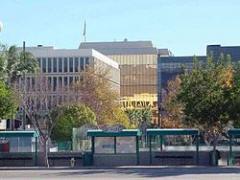
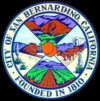
San Bernardino is a city located in the Riverside-San Bernardino metropolitan area (sometimes called the "Inland Empire"). It serves as the county seat of San Bernardino County, California, United States. As one of the Inland Empire's anchor cities, located about 55 miles (89 km) east of Downtown Los Angeles, San Bernardino spans 81 square miles (210 km2) on the floor of the San Bernardino Valley, and has a population of 209,924 as of the 2010 census. San Bernardino is the 17th largest city in California, and the 99th largest city in the United States.
California State University, San Bernardino is located in the northeastern part of the city. The university also hosts the Coussoulis Arena. Other attractions in San Bernardino include ASU Fox Theatre, the McDonald's Museum, which is located on the original site of the world's first McDonald's (at 34 °07 a²32 a³N 117 °17 a²41 a³W / 34.1255 °N 117.2946 °W / 34.1255; -117.2946), California Theatre, the San Bernardino Mountains, and San Manuel Amphitheater, the largest outdoor amphitheater in the United States. In addition, the city is home to the Inland Empire 66ers of San Bernardino baseball team, they play their home games at San Manuel Stadium in downtown San Bernardino.
In July 2012, San Bernardino became the largest city ever to choose to file for protection under Chapter 9 of the U.S. Bankruptcy code. The case was filed on August 1.
San Bernardino is the poorest city of its population size in California, and the second poorest in the US next to Detroit, Michigan.
The city of San Bernardino, California, occupies much of the San Bernardino Valley, which indigenous tribespeople originally referred to as "The Valley of the Cupped Hand of God". The Tongva Indians also called the San Bernardino area Wa'aach in their language. Upon seeing the immense geological arrowhead-shaped rock formation on the side of the San Bernardino Mountains, they found the hot and cold springs to which the "arrowhead" seemed to point.
The city of San Bernardino is one of the oldest communities in the state of California. Named for Bernardino of Siena on May 20, 1810, San Bernardino, in its present-day location, was not largely settled until 1851, after California became a state. The first Anglo-American colony was established by pioneers associated with The Church of Jesus Christ of Latter-day Saints who would be recalled by Brigham Young in 1857 due to the Utah War. The city was officially incorporated in the year 1857. Soon afterward, San Bernardino became an important trading hub in Southern California.
Near San Bernardino is a naturally formed arrowhead-shaped rock formation on the side of a mountain. It measures 1375 feet by 449 feet. According to the Native American legend regarding the landmark arrowhead, an arrow from heaven burned the formation onto the mountainside in order to show tribes where they could be healed. During the mid-19th century, "Dr." David Noble Smith claimed that a saint-like being appeared before him and told of a far-off land with exceptional climate and curative waters, marked by a gigantic arrowhead. Smith's search for that unique arrowhead formation began in Texas, and eventually ended at Arrowhead Springs in California in 1857. By 1889, word of the springs, along with the hotel on the site (and a belief in the effect on general health of the water from the springs) had grown considerably. Hotel guests often raved about the crystal-clear water from the cold springs, which prompted Seth Marshall to set up a bottling operation in the hotel's basement. By 1905, water from the cold springs was being shipped to Los Angeles under the newly created "Arrowhead" trademark.
Indigenous people of the San Bernardino Valley and Mountains were collectively identified by Spanish explorers in the 19th century as Serrano, a term meaning highlander. Serrano living near what is now Big Bear Lake were called Yuhaviatam, or "People of the Pines". In 1866, to clear the way for settlers and gold miners, state militia conducted a 32-day campaign slaughtering men, women, and children. Yuhaviatam leader Santos Manuel guided his people from their ancient homeland to a village site in the San Bernardino foothills. The United States government in 1891 established it as a tribal reservation and named it after Santos Manuel.
In 1867, the first Chinese immigrants arrived in San Bernardino.
In 1883, California Southern Railroad established a rail link through San Bernardino between Los Angeles and the rest of the country.
In 1905, the city of San Bernardino passed its first charter.
World War II brought Norton Air Force Base.
In 1940, Richard and Maurice McDonald founded McDonald's, along with its innovative restaurant concept, in the city.
In 1980, the Panorama Fire destroyed 284 homes. In October 2003, another wildfire, the Old Fire, destroyed over 1,000 homes.
San Bernardino won the All-American City award in the early 1980s, but the city subsequently went into general decline and has only recently begun to recover from the three recessions of the late 20th/early 21st centuries.
In 1994, Norton Air Force Base closed to become San Bernardino International Airport.

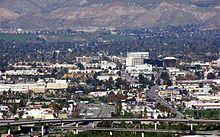
According to the United States Census Bureau, the city has a total area of 59.6 square miles (154 km2), of which 59.2 square miles (153 km2) is land and 0.4 square miles (1.0 km2), or 0.74%, is water.
The city lies in the San Bernardino foothills and the eastern portion of the San Bernardino Valley, roughly 65 miles (105 km) east of Los Angeles. Some major geographical features of the city include the San Bernardino Mountains and the San Bernardino National Forest, in which the city's northernmost neighborhood, Arrowhead Springs, is located; the Cajon Pass adjacent to the northwest border; City Creek, Lytle Creek, San Timoteo Creek, Twin Creek, Warm Creek (as modified through flood control channels) feed the Santa Ana River, which forms part of the city's southern border south of San Bernardino International Airport.
San Bernardino is unique among Southern Californian cities because of its wealth of water, which is mostly contained in underground aquifers. A large part of the city is over the Bunker Hill Groundwater Basin, including downtown. This fact accounts for an historically high water table in portions of the city, including at the former Urbita Springs, a lake which no longer exists and is now the site of the Inland Center Mall. Seccombe Lake, named after a former mayor, is a manmade lake at Sierra Way and 5th Street. The San Bernardino Valley Municipal Water District ("Muni") has plans to build two more large, multi-acre lakes north and south of historic downtown in order to reduce groundwater, mitigate the risks of liquefaction in a future earthquake, and sell the valuable water to neighboring agencies.
The city has several notable hills and mountains; among them are: Perris Hill (named after Fred Perris, an early engineer, and the namesake of Perris, California); Kendall Hill (which is near California State University); and Little Mountain, which rises among Shandin Hills (generally bounded by Sierra Way, 30th Street, Kendall Drive, and Interstate 215).
Freeways act as significant geographical dividers for the city of San Bernardino. Interstate 215 is the major east-west divider, while State Route 210 is the major north-south divider. Interstate 10 is in the southern part of the city. Other major highways include State Route 206 (Kendall Drive and E Street); State Route 66 (which includes the former U.S. 66); State Route 18 (from State Route 210 north on Waterman Avenue to the northern City limits into the mountain communities), and State Route 259, the freeway connector between State Route 210 and I-215.
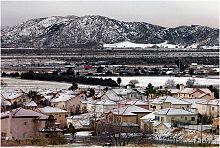
San Bernardino features a somewhat cooler version of a Mediterranean climate with cool to chilly winters (frost is common during this time of the year) and hot, dry summers. Relative to other areas in Southern California, winters are colder, with frost and with chilly to cold morning temperatures common. The particularly arid climate during the summer prevents tropospheric clouds from forming, meaning temperatures rise to what is considered by NOAA scientists as Class Orange. Summer is also a lot warmer with the highest recorded summer temperature at 117 °F (47.2 °C) in 1971. In the winter, snow flurries occur upon occasion. San Bernardino gets an average of 16 inches (41 cm) of rain, hail, or light snow showers each year. Arrowhead Springs, San Bernardino's northernmost neighborhood, gets snow, heavily at times due to its elevation of about 3,000 feet (910 m) above sea level.
The seasonal Santa Ana winds are felt particularly strongly in the San Bernardino area as warm and dry air is channeled through nearby Cajon Pass at times during the autumn months. This phenomenon markedly increases the wildfire danger in the foothills, canyon, and mountain communities that the cycle of cold, wet winters and dry summers helps create.
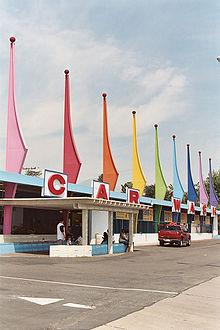
The neighborhoods of San Bernardino are not commonly named. Some reflect geographical regions that existed before annexation, and others originated with specific housing developments. Arrowhead Springs extends from the historic Arrowhead Springs Hotel and Spa in the north to I-210 in the south and from Shandin Hills in the west to east Twin Creek in the east. Del Rosa is the area generally between the foothills and Highland, Mountain and Arden Avenues. Delmann Heights is the area north of Highland Avenue, west of I-215, and east of the unincorporated area of Muscoy, California (which is within the city's sphere of influence for annexation as well as Devore). Some portions of Highland are within the city of San Bernardino, generally consistent with the portions of historical "West Highlands" north of Highland Avenue. The city also contains the post office for Patton, California, the area coextensive with Patton Hospital. Mountain Shadows is the development name for the area between Palm Avenue and Highland Avenue to State Route 330. The "West Side" is used generically to refer to the areas West of I-215. North Loma Linda is the area west of Mountain View Acres (the border with Redlands), south of the Santa Ana River, north of the San Bernardino Freeway (I-10), and east of Tippecanoe Avenue. The area north of Northpark Boulevard from University Parkway to Electric Avenue, and the area north of 40th Street from Electric Avenue to Harrison Street is called Newberry Farms. The area west of University Parkway, and north of Kendall Drive to the north city area is called Verdemont. The "Bench" or "Rialto Bench" refers to the area with Rialto mailing addresses between Foothill Boulevard and Base Line Street.
San Bernardino is divided into several districts. Many hotels, restaurants, and retail establishments have been built around Hospitality Lane in the southern part of the city, creating an informal business district. Downtown is its own district with shopping and government buildings. In the foothills of the San Bernardino Mountains lies the University District, which is a commercial area designed to support the California State University with shopping, dining, and high-density residential space. On the southern side of I-215 and the University District is the Cajon Pass light-industrial district where warehouses are situated to take advantage of this important connection between Southern California and the rest of the United States. On the opposite side of the city is the San Bernardino International Gateway, which encompasses the San Bernardino International Airport (SBD) and the Alliance California Logistics campus (air cargo hub). Nearby is the Burlington Northern Santa Fe rail hub. The combination of these assets (airport; rail hub; extensive freeway system; and, Cajon Pass) makes the city important in the movement of goods and people between Southern California and the rest of the United States.
The city of San Bernardino is in the process of developing an historic district around the 1918 Santa Fe Depot, which recently underwent a $15.6 million restoration. When completed, this area will connect to the downtown district with period street lights and street furniture, historic homes and other structures, a new museum, coffee bars and, a mercado with an architectural style in keeping with the Mission Revival station.
San Bernardino has three unincorporated communities known for residences of millionaires and increasingly affluent sections of town: Del Rosa, Muscoy, University Heights (Kendall Farms) and University Hills, and Verdemont.
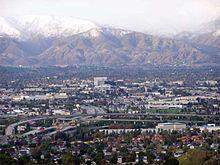
The 2010 United States Census reported that San Bernardino had a population of 209,924. The population density was 3,519.6 people per square mile (1,358.9/km ²). The racial makeup of San Bernardino was 95,734 (45.6%) White, 31,582 (15.0%) African American, 2,822 (1.3%) Native American, 8,454 (4.0%) Asian, 839 (0.4%) Pacific Islander, 59,827 (28.5%) from other races, and 10,666 (5.1%) from two or more races. Hispanic or Latino of any race were 125,994 persons (60.0%). Non-Hispanic Whites were 19.0% of the population in 2010, compared to 65.6% in 1970.
The Census reported that 202,599 people (96.5% of the population) lived in households, 3,078 (1.5%) lived in non-institutionalized group quarters, and 4,247 (2.0%) were institutionalized.
There were 59,283 households, out of which 29,675 (50.1%) had children under the age of 18 living in them, 25,700 (43.4%) were opposite-sex married couples living together, 13,518 (22.8%) had a female householder with no husband present, 5,302 (8.9%) had a male householder with no wife present. There were 5,198 (8.8%) unmarried opposite-sex partnerships, and 488 (0.8%) same-sex married couples or partnerships. 11,229 households (18.9%) were made up of individuals and 4,119 (6.9%) had someone living alone who was 65 years of age or older. The average household size was 3.42. There were 44,520 families (75.1% of all households); the average family size was 3.89.
The population was spread out with 67,238 people (32.0%) under the age of 18, 26,654 people (12.7%) aged 18 to 24, 56,221 people (26.8%) aged 25 to 44, 43,277 people (20.6%) aged 45 to 64, and 16,534 people (7.9%) who were 65 years of age or older. The median age was 28.5 years. For every 100 females there were 97.2 males. For every 100 females age 18 and over, there were 94.0 males.
There were 65,401 housing units at an average density of 1,096.5 per square mile (423.4/km ²), of which 29,838 (50.3%) were owner-occupied, and 29,445 (49.7%) were occupied by renters. The homeowner vacancy rate was 3.2%; the rental vacancy rate was 9.5%. 102,650 people (48.9% of the population) lived in owner-occupied housing units and 99,949 people (47.6%) lived in rental housing units.
Western, central, and parts of eastern San Bernardino are home to mixed-ethnic low-income populations, of which the Latino and African American populations dominate. Historically, many Latinos, primarily Mexican-Americans and Mexicans lived on Mount Vernon Avenue on the West Side, while the Medical Center (formerly known as Muscot) and Base Line corridors were mostly black since the 1960s, in particular in the east side and west side areas centering on public housing projects Waterman Gardens and the public housing on Medical Center drive. The heart of the Mexican-American community is on the West and Southside of San Bernardino, but is slowly expanding throughout the entire city. San Bernardino's only Jewish congregation moved to Redlands in December 2009. Some Asian-Americans live in and around the city of San Bernardino, like a late 19th century-era (gone) Chinatown and formerly Japanese-American area in Seccombe Park on the east end of downtown and currently, a large East-Asian community in North Loma Linda as well in nearby Loma Linda to the south across the Santa Ana River serves as an example.
Government, retail, and service industries dominate the economy of the city of San Bernardino. From 1998 to 2004, San Bernardino's economy grew by 26,217 jobs, a 37% increase, to 97,139. Government was both the largest and the fastest-growing employment sector, reaching close to 20,000 jobs in 2004. Other significant sectors were retail (16,000 jobs) and education (13,200 jobs).
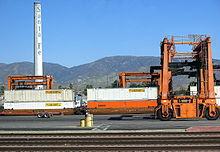
The city's location close to the Cajon and San Gorgonio passes, and at the junctions of the I-10, I-215, and SR-210 freeways, positions it as an intermodal logistics hub. The city hosts the Burlington Northern and Santa Fe Railway's Intermodal freight transport yard, the Yellow Freight Systems' cross-docking trucking center, and Pacific Motor Trucking. Large warehouses for Kohl's, Mattel, Pep Boys, and Stater Bros. have been developed near the San Bernardino International Airport.
Over the last few decades, the city's riverfront district along Hospitality Lane has drawn much of the regional economic development away from the historic downtown of the city so that the area now hosts a full complement of office buildings, big-box retailers, restaurants, and hotels situated around the Santa Ana River.
The closure of Norton Air Force Base in 1994 caused the loss of 10,000 highly skilled military and civilian jobs, emptied whole neighborhoods, and sent San Bernardino's economy into a significant downturn that has been somewhat offset by more recent growth in the intermodal logistics industry. The jobless rate in the region swelled to more than 12 percent during the years immediately after the base closure, and even today households within one mile (1.6 km) of the city core have a median income of only $20,480, less than half that of the Inland region as a whole. Over 15 percent of San Bernardino residents are unemployed as of 2012, and over 40 percent are on some form of public assistance. According to the US Census, 34.6 percent of residents live below the poverty level, making San Bernardino the poorest city for its population in California, and the second poorest in the US next to Detroit.
Amazon.com has built a new 950,000-square-foot (22-acre) fulfillment warehouse on the south side of the airport, scheduled to open in fall of 2012, promising to create 1,000 new jobs, which will make it one of the city's largest employers.
According to the city's 2010 Comprehensive Annual Financial Report, the top employers in the city are:
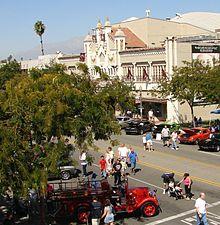
San Bernardino hosts several major annual events, including: Route 66 Rendezvous, a four-day celebration of America's "Mother Road" that is held in downtown San Bernardino each September; the Berdoo Bikes & Blues Rendezvous, held in the spring; the National Orange Show Festival, a citrus exposition founded in 1911 and also held in the spring; and, the Western Regional Little League Championships held each August, as well as the annual anniversary of the birth of the Mother Charter of the Hells Angels Motorcycle Club, Berdoo California Chapter.
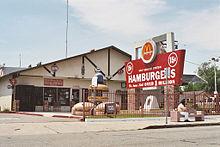
The Robert V. Fullerton Museum of Art, located on the campus of California State University, San Bernardino, contains a collection of Egyptian antiquities, ancient pottery from present-day Italy, and funerary art from ancient China. In addition to the extensive antiquities on display, the museum presents contemporary art and changing exhibitions.
The Heritage House holds the collection of the San Bernardino Historic and Pioneer Society, while the San Bernardino County Museum of regional history, in Redlands, has exhibits relating to the city of San Bernardino, as well.
The San Bernardino Railroad and History Museum is located inside the historic Santa Fe Depot. A Route 66 museum is located on the historic site of the original McDonald's restaurant. at 1398 North E Street and West 14th Street.
Specialty museums include the Inland Empire Military Museum, the American Sports Museum, and the adjacent WBC Legends of Boxing Museum.
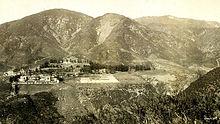
San Bernardino is home to the historic Arrowhead Springs Hotel and Spa, located in the Arrowhead Springs neighborhood, which encompasses 1,916 acres (7.75 km2) directly beneath the Arrowhead geological monument that presides over the San Bernardino Valley. The resort contains hot springs, in addition to mineral baths and steam caves located deep underground. Long the headquarters for Campus Crusade for Christ, the site now remains largely vacant and unused since their operations moved to Florida.
The $300 million Casino San Manuel, one of the few in southern California that does not operate as a resort hotel, is located approximately one mile from the Arrowhead Springs Hotel and Spa.
In downtown, Clarion, adjacent to the San Bernardino Convention Center, is the largest hotel while the Hilton is the largest in the Hospitality Lane District.
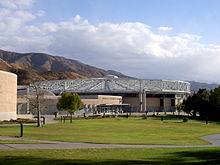
California State University, San Bernardino (CSUSB) Coyotes compete at the NCAA Division II level in a variety of sports. In 2007, the Coyotes' men's basketball team competed in the Division II Final Four in Springfield, Massachusetts. However, only San Bernardino Valley College plays football at the collegiate level.
CSUSB used to play their home baseball games at the downtown venue, Arrowhead Credit Union Park, but now play all their home games at the Uptown venue, Fiscalini Field.
San Bernardino has had other professional and semi-pro teams over the years, including the San Bernardino Jazz professional women's volleyball team, the San Bernardino Pride Senior Baseball team, and the San Bernardino Spirit California League Single A baseball team.
San Bernardino also hosts the BSR West Super Late Model Series at Orange Show Speedway. The series fields many drivers, including NASCAR Camping World Truck Series regular Ron Hornaday, who drove the No. 33 in a race on July 12, 2008.
The city hosts the Inland Empire 66ers of San Bernardino baseball club of the California League, which was the Los Angeles Dodgers Single A affiliate from 2007 ae2010. In 2011, the 66ers became the Los Angeles Angels Single A affiliate. The 66ers play at San Manuel Stadium in downtown San Bernardino.
Word Count: 4366






